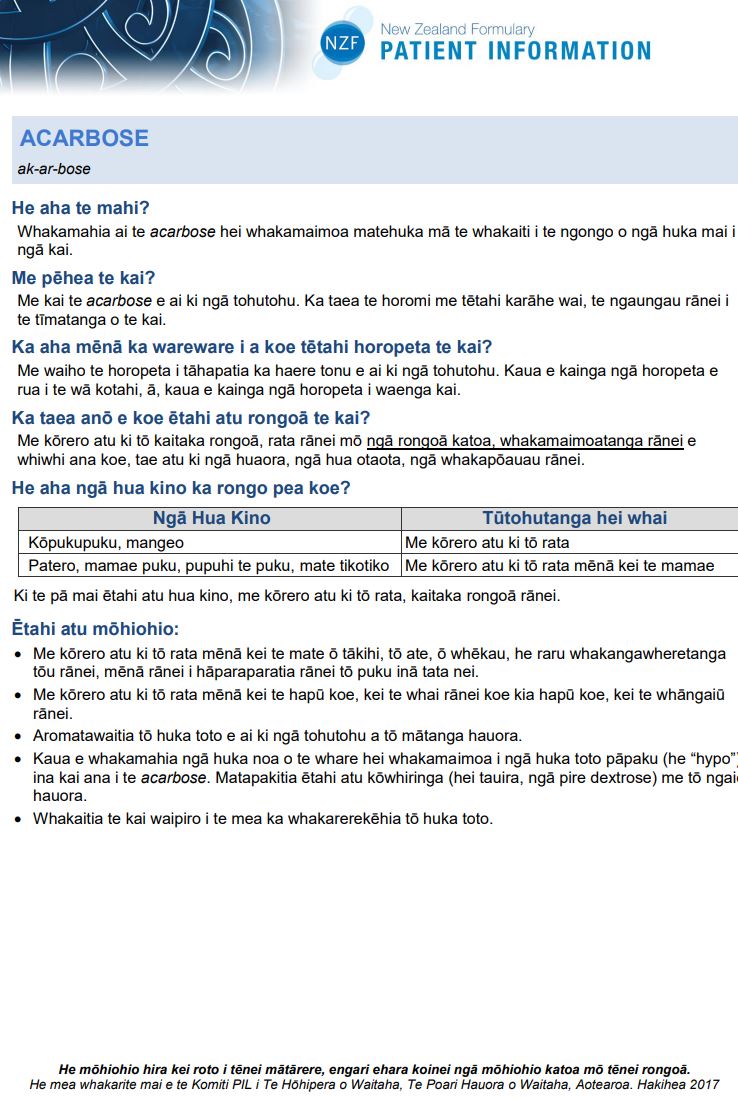Acarbose is used to treat type 2 diabetes, together with exercise, good nutrition, weight loss and other lifestyle measures. It may be used alone or with other medicines for diabetes. Acarbose works by slowing the digestion and absorption of carbohydrates (sugars) and in this way lowers high blood glucose after each meal. To work properly acarbose must be taken at the start of a meal (with the first bites). Read more about type 2 diabetes and medicines for type 2 diabetes.
Low or no data? Visit zero.govt.nz, scroll down the page then click on our logo to return to our site and browse for free.
Acarbose
Sounds like 'ah-KAR-bose'
Key points about acarbose
- Acarbose is used to treat type 2 diabetes.
- Acarbose is also called Accarb.
- Find out how to take it safely and possible side effects.

In Aotearoa New Zealand acarbose is available as tablets (50 mg and 100 mg).
- The starting dose of acarbose is 50 milligrams 3 times a day.
- Depending on your blood glucose level, your doctor may increase your dose to 100 milligrams 3 times a day. Some people may need a higher dose.
- Always take your acarbose exactly as your doctor has told you. The pharmacy label on your medicine will tell you how much acarbose to take, how often to take it and any special instructions.
- Timing of your doses: Swallow your tablet with a drink of water at the beginning of a meal, or if you prefer, you can chew the tablet with your first mouthful of food. Acarbose should be taken 3 times a day, with breakfast, lunch and dinner. Do not take it between meals or with small snacks.
- Missed dose: If you forget your dose with your meal, wait to take the next dose with your next meal. Do not take double the dose and do not take the tablets between meals.
- Keep taking acarbose regularly. To control your diabetes, you must keep taking acarbose every day.
Here are some things to know when you're taking acarbose. Other things may be important as well, so ask your healthcare provider what you should know about.
- Avoid eating sucrose-containing products such as sugar, soft drinks or lollies. They may cause stomach pain or even runny poo (diarrhoea) if taken while you are on acarbose tablets.
- Acarbose can interact with some other medicines and herbal supplements, so check with your doctor or pharmacist before starting acarbose and before starting any new products.
- If you are sick and not eating, ask your healthcare provider for advice. They may recommend that you stop taking acarbose until you are better. Read more about diabetes sick day plan.
Like all medicines, acarbose can cause side effects, although not everyone gets them. Often side effects improve as your body gets used to the new medicine.
| Side effects | What should I do? |
|---|---|
|
|
|
|
|
|
|
|
|
|
| For more information on side effects, see the Medsafe consumer information leaflets Glucobay(external link) and Accarb(external link). Did you know that you can report a side effect to a medicine to CARM (Centre for Adverse Reactions Monitoring)? Report a side effect to a product(external link) |
|
The following links have more information on acarbose.
Acarbose(external link) (te reo Māori(external link)) NZ Formulary Patient Information
Glucobay(external link) Medsafe Consumer Information Sheet
References
- Acarbose(external link) New Zealand Formulary
- Managing patients with type 2 diabetes: from lifestyle to insulin(external link) BPAC, NZ, 2015
- Glucobay(external link) Medsafe Datasheet
Brochures

My Medicines, NZ, 2017

Health Quality and Safety Commission, NZ, 2019
EnglishTe reo Māori
Credits: Sandra Ponen, Pharmacist, Healthify He Puna Waiora. Healthify is brought to you by Health Navigator Charitable Trust.
Reviewed by: Angela Lambie, Pharmacist, Auckland
Last reviewed:
Page last updated:





